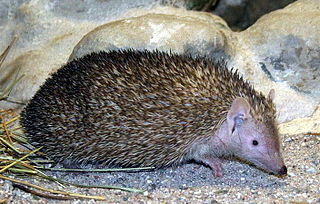
The clade Afrosoricida contains the golden moles of Southern Africa, the otter shrews of equatorial Africa and the tenrecs of Madagascar. These three groups of small mammals were for most of the 19th and 20th centuries regarded as a part of the Insectivora or Lipotyphla, but both of those groups, as traditionally used, are polyphyletic.

A tenrec is a mammal belonging to any species within the afrotherian family Tenrecidae, which is endemic to Madagascar. Tenrecs are a very diverse group; as a result of convergent evolution, some resemble hedgehogs, shrews, opossums, rats, and mice. They occupy aquatic, arboreal, terrestrial, and fossorial environments. Some of these species, including the greater hedgehog tenrec, can be found in the Madagascar dry deciduous forests. However, the speciation rate in this group has been higher in humid forests.
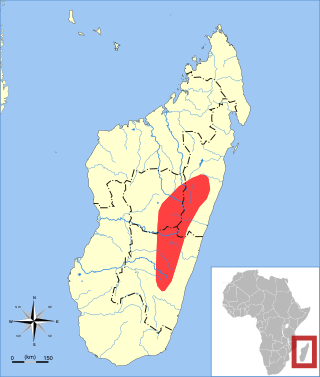
The web-footed tenrec, Malagasy otter shrew, or aquatic tenrec is the only known semiaquatic tenrec, and is found in eastern Madagascar, especially in and around Ranomafana National Park. It grows to between 25 and 39 cm, and was once thought to be extinct. It feeds on crabs, aquatic insects, and crayfish. The population is considered vulnerable. It was formerly placed in the monotypic genus Limnogale, but has been moved to Microgale based on molecular data showing it to be deeply nested within the latter.
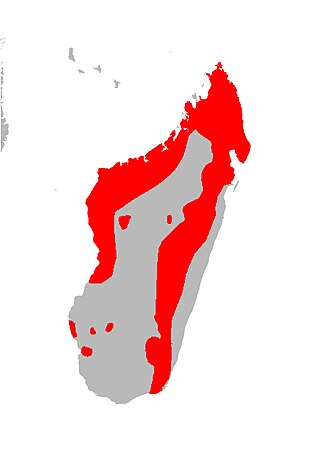
Microgale is a genus of mammal in the family Tenrecidae. There are 21 living species on the island of Madagascar and one extinct species known from a fossil. Some species have been discovered in the last twenty years.

Cowan's shrew tenrec is a species of mammal in the family Tenrecidae.
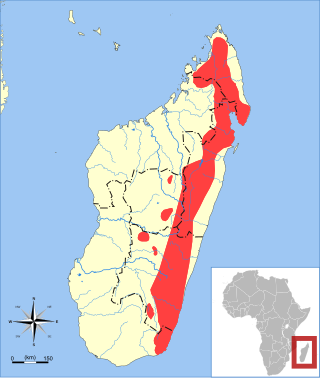
Dobson's shrew tenrec is a species of mammal in the family Tenrecidae. It is endemic to Madagascar. Its natural habitats are subtropical or tropical moist forests, plantations, and heavily degraded former forest. On the basis of molecular data indicating that it and Talazac's shrew tenrec form a sister group to the rest of Microgale, these two species were transferred from Microgale to Nesogale in 2016.

The dryad shrew tenrec, also known as the tree shrew tenrec, is a species of mammal in the family Tenrecidae. It is endemic to Madagascar. Its natural habitat is subtropical or tropical moist lowland forests.

The pale shrew tenrec, also known as the pale-footed shrew tenrec is a species of mammal in the family Tenrecidae. It is endemic to Madagascar. Its natural habitats are subtropical and tropical moist lowland and montane forests.

Jenkins's shrew tenrec is a species of mammal in the family Tenrecidae. It is endemic to Madagascar. Its natural habitats are subtropical or tropical dry forests and shrubland. It is threatened by habitat loss.

The pygmy shrew tenrec is a species of placental mammal in the family Tenrecidae. It is endemic to Madagascar. Its natural habitat is subtropical or tropical moist forests. While it is not endangered, its population is slowly declining as it is threatened by habitat loss. This is of concern, though does not yet merit a higher protection level.

The greater long-tailed shrew tenrec is a species of mammal in the family Tenrecidae. It is endemic to Madagascar, where its natural habitats are subtropical or tropical moist forests.

Talazac's shrew tenrec is a species of mammal in the family Tenrecidae. It is endemic to Madagascar. Its natural habitats are subtropical or tropical moist forests. On the basis of molecular data indicating that it and Dobson's shrew tenrec form a sister group to the rest of Microgale, these two species were transferred from Microgale to Nesogale in 2016.

Thomas's shrew tenrec is a species of mammal in the family Tenrecidae. It is endemic to Madagascar. Its natural habitat is subtropical or tropical moist lowland forests.

The northern shrew tenrec is a species of mammal in the family Tenrecidae. It is endemic to Madagascar, where it has a restricted disjoint range in two locations 485 km apart in the north and east of the island. In the north, it is found on the southwestern slopes of the Tsaratanana Massif at elevations from 1420 to 1680 m. In central eastern Madagascar, it is found in the Ambatovy Forest. Its natural habitat is montane forest. The species is most closely related to the widely distributed M. cowani. This tenrec is threatened by deforestation from agricultural conversion, lumbering and mining.

Microgale macpheei is an extinct shrew tenrec from southeastern Madagascar. It is known only from two partial skulls found in Andrahomana cave, which radiocarbon dating of associated rodent remains suggests are about 3000 years old. It is the only known recently extinct tenrec. First described in 2007, it is most similar to the smaller Microgale brevicaudata of northern and western Madagascar. M. macpheei has a broad rostrum and, like M. brevicaudata, lacks a diastema (gap) between the premolars. A number of details of tooth morphology are characteristic of M. macpheei.
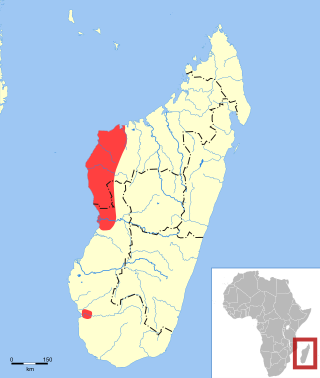
Microgale grandidieri, also known as Grandidier's shrew tenrec, is a species of shrew tenrec occurring in the dry forests of western and southwestern Madagascar. Populations of this species were formerly included in Microgale brevicaudata; M. grandidieri was described as a separate species in 2009 based on differences in morphology and DNA sequences.
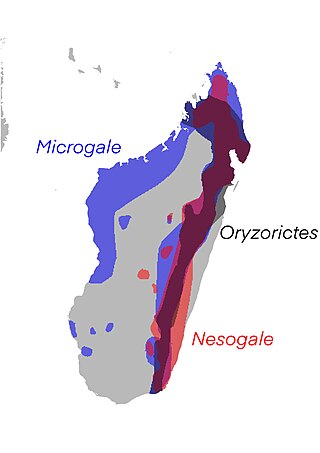
Oryzorictinae is a subfamily of tenrecs endemic to the island of Madagascar. It is the largest of three tenrec subfamilies. Oryzorictinae is thought to have split from the lineage of its closest relative, Geogale, about 30 million years (Ma) ago. The deepest phylogenetic split within the subfamily, that between Oryzorictes and a clade composed of Microgale plus Nesogale, is thought to have occurred about 28 Ma ago. In turn, Microgale and Nesogale are thought to have diverged about 19 Ma ago.
Ixodes microgalei is a species of Ixodes that was discovered in the humid eastern forests of the Antananarivo Province in Madagascar. Females of this species parasitize various species of shrew tenrecs of the genus Microgale. All members of the genus Microgale, as well as of the larger subfamily to which that genus belongs, are endemic to Madagascar.

















